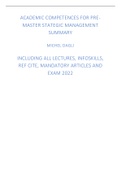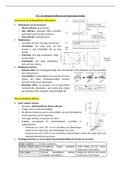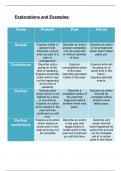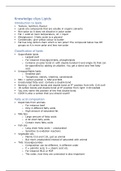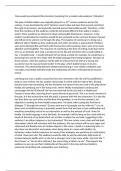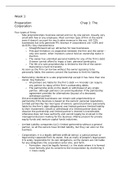Werkcollege 3
Opdracht Care@Home
B
o a.
- Although less care is provided during the evenings and weekends, and even less
during the night (23 hr – 7 hr), Care@Home is a 24/7 operation. 69-71
- At the client side the time needed for each client varies both per visit, and from day to
day. 76-77
- The time travel needed to go from one patient to the next can’t be reliably predicted
most of the times. 78-79
- The actual times of arrival at a client hardly ever match the scheduled time. 79-80
- One caregiver is so much later and because of that the colleague coming early has to
wait. 81-82
- Clients see a lot of different employees and feel this is unpleasant. 83-84
- Special requests make by the clients are for 70% not met. 86-89
- Supervisors only respond to ‘more care-signals’, but tend to forget to follow uo on
‘less’ ones 99-100.
- Employees complain they spend more time travelling between clients than caring for
them. 106-107
- Employees want electrical bike in stead of smart-for-two. 107-108
- Caregivers complain about parking problems and lost time. 109-110
- Caregivers resist using the QR-codes at the moment of entering and leaving. 111-112.
There is a penalty for this. 119
- No registration exists of the special client request and therefore there is no knowing
how many are accepted/planned/denied. 122-124
- Help desk is consuming to much time 128-129
- Integrated forms are too complicated. 138-141
- Supervisors complain about their span of control this is too wide due to the
parttimers. 152-154
- They spend too much time finding replacements. 155
- They feel unable to give enough attention to sick staff. 156-158
- Supervisors feel overloaded. 159-160
- Caregivers are unhappy that they have to leave the client when they did their part of
the care 166-170
- Growing distance between caregivers and the higher paid staff at head office. 177-179
- High Costs because of expensive new ICT and costs for replacement staff. 182-183
- Direct-indirect ratio of staff is wrong. 188
o b.
Niet van toepassing
o c.
Parameter 1: Functionele concentratie Laag. Caregivers voeren maar een kleine taak uit
onderverdeeld in household, personal & nursery.
, Parameter 2: Differentiatie van het transformatieproces (scheiden) Hoog, de organisatie is
opgesplitst in veel verschillende afdelingen die van elkaar afhankelijk zijn.
Parameter 3: Specialisatie van het transformatieproces (splitsen) Hoog, voor elke taak
komt er iemand anders.
Parameter 4: Scheiden regelraken van operationele Hoog. Er zijn veel ondersteunende
afdelingen en je hebt ook per productieafdeling 1 teamleider.
Parameter 5: Differentiatie van regeltaken in aspecten Hoog. Er is veel hiërarchie binnen
de organisatie.
Parameter 6: Differentiatie van regeltaken in onderdelen Hoog. De verschillende taken
voor caregivers zijn erg opgesplitst, hierdoor hebben de cliënten voortdurend met
verschillende mensen te maken.
Parameter 7: Specialisatie van regeltaken Hoog. Elke client heeft verschillende vormen
van zorg nodig en die worden door verschillende caregivers gegeven.
Parameter 8:
o d.
Nr. Regel Probleem/Dreiging Oorzaak: Structuur:
Ja/Nee
1 69-71 Although less care is provided Sommige klanten Ja
during the evenings and hebben in de nacht
weekends, and even less during hulp nodig.
the night (23 hr – 7 hr),
Care@Home is a 24/7
operation.
2 76-77 At the client side the time Iedere klant heeft op Nee
needed for each client varies een ander moment
both per visit, and from day to hulp nodig.
day.
3 78-79 The time travel needed to go Door het verkeer. Nee
from one patient to the next
can’t be reliably predicted most
of the times.
4 79-80 The actual times of arrival at a Slecht ingepland en Ja
client hardly ever match the de caregivers zijn
scheduled time. overbeladen met
werk.
5 81-82 One caregiver is so much later De caregivers zijn Ja
and because of that the overbeladen.
colleague coming early has to
wait.
Opdracht Care@Home
B
o a.
- Although less care is provided during the evenings and weekends, and even less
during the night (23 hr – 7 hr), Care@Home is a 24/7 operation. 69-71
- At the client side the time needed for each client varies both per visit, and from day to
day. 76-77
- The time travel needed to go from one patient to the next can’t be reliably predicted
most of the times. 78-79
- The actual times of arrival at a client hardly ever match the scheduled time. 79-80
- One caregiver is so much later and because of that the colleague coming early has to
wait. 81-82
- Clients see a lot of different employees and feel this is unpleasant. 83-84
- Special requests make by the clients are for 70% not met. 86-89
- Supervisors only respond to ‘more care-signals’, but tend to forget to follow uo on
‘less’ ones 99-100.
- Employees complain they spend more time travelling between clients than caring for
them. 106-107
- Employees want electrical bike in stead of smart-for-two. 107-108
- Caregivers complain about parking problems and lost time. 109-110
- Caregivers resist using the QR-codes at the moment of entering and leaving. 111-112.
There is a penalty for this. 119
- No registration exists of the special client request and therefore there is no knowing
how many are accepted/planned/denied. 122-124
- Help desk is consuming to much time 128-129
- Integrated forms are too complicated. 138-141
- Supervisors complain about their span of control this is too wide due to the
parttimers. 152-154
- They spend too much time finding replacements. 155
- They feel unable to give enough attention to sick staff. 156-158
- Supervisors feel overloaded. 159-160
- Caregivers are unhappy that they have to leave the client when they did their part of
the care 166-170
- Growing distance between caregivers and the higher paid staff at head office. 177-179
- High Costs because of expensive new ICT and costs for replacement staff. 182-183
- Direct-indirect ratio of staff is wrong. 188
o b.
Niet van toepassing
o c.
Parameter 1: Functionele concentratie Laag. Caregivers voeren maar een kleine taak uit
onderverdeeld in household, personal & nursery.
, Parameter 2: Differentiatie van het transformatieproces (scheiden) Hoog, de organisatie is
opgesplitst in veel verschillende afdelingen die van elkaar afhankelijk zijn.
Parameter 3: Specialisatie van het transformatieproces (splitsen) Hoog, voor elke taak
komt er iemand anders.
Parameter 4: Scheiden regelraken van operationele Hoog. Er zijn veel ondersteunende
afdelingen en je hebt ook per productieafdeling 1 teamleider.
Parameter 5: Differentiatie van regeltaken in aspecten Hoog. Er is veel hiërarchie binnen
de organisatie.
Parameter 6: Differentiatie van regeltaken in onderdelen Hoog. De verschillende taken
voor caregivers zijn erg opgesplitst, hierdoor hebben de cliënten voortdurend met
verschillende mensen te maken.
Parameter 7: Specialisatie van regeltaken Hoog. Elke client heeft verschillende vormen
van zorg nodig en die worden door verschillende caregivers gegeven.
Parameter 8:
o d.
Nr. Regel Probleem/Dreiging Oorzaak: Structuur:
Ja/Nee
1 69-71 Although less care is provided Sommige klanten Ja
during the evenings and hebben in de nacht
weekends, and even less during hulp nodig.
the night (23 hr – 7 hr),
Care@Home is a 24/7
operation.
2 76-77 At the client side the time Iedere klant heeft op Nee
needed for each client varies een ander moment
both per visit, and from day to hulp nodig.
day.
3 78-79 The time travel needed to go Door het verkeer. Nee
from one patient to the next
can’t be reliably predicted most
of the times.
4 79-80 The actual times of arrival at a Slecht ingepland en Ja
client hardly ever match the de caregivers zijn
scheduled time. overbeladen met
werk.
5 81-82 One caregiver is so much later De caregivers zijn Ja
and because of that the overbeladen.
colleague coming early has to
wait.

